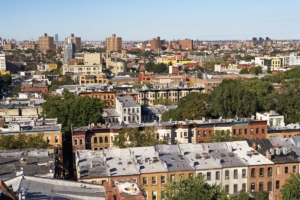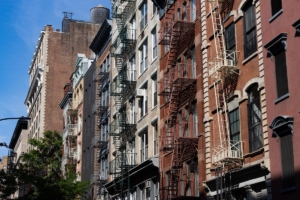Both Manhattan and Brooklyn kicked off the year with declining monthly median rent for the first time since 2010, according to the January 2017 StreetEasy® Market Reports[i]. The least expensive areas were the only pockets of rent growth, with all others experiencing month-over-month declines. Annual numbers echo this trend, with only Upper Manhattan, South Brooklyn and East Brooklyn median rents continuing to rise.
From StreetEasy economist Krishna Rao:
“Manhattan and Brooklyn renters could finally be catching a break in 2017,” said StreetEasy economist Krishna Rao. “Over almost a decade, rents in both boroughs have had strong growth and consistently hit new highs time and time again. Over the last few months the landscape has shifted. The luxury decline seems to be affecting the market in a big way, as the most expensive areas see the greatest rent declines, while competition remains relatively heightened in less expensive areas like Upper Manhattan and South Brooklyn.”
Median Rent Declines Month-over-Month
- In Manhattan, median rent fell 0.5 percent month-over-month to $3,198, marking five consecutive months of median rent declines[ii].
- Rents in almost all submarkets declined compared to December 2016. Upper Manhattan remains the exception, with a median rent increase of only 0.1 percent month-over-month.
- Brooklyn’s median rent decreased 0.8 percent month-over-month to $2,806, the sixth consecutive month of rent declines.
- Rent decreased month-over-month in almost all Brooklyn submarkets, except in South Brooklyn where median rent remained flat since last month at $1,768.
- The decline was greatest in North Brooklyn, which includes Williamsburg and Greenpoint, decreasing 1.8 percent month-over-month.
[tableau server=”public.tableau.com” workbook=”Jan2017RentIndexMonthlyChange” view=”Jan2017MonthlyRentChange” tabs=”no” toolbar=”no” revert=”” refresh=”yes” linktarget=”” width=”600px” height=”820px”][/tableau]
Annual Growth Hits New Lows
- Manhattan’s median rent increased 0.3 percent year-over-year, the slowest pace of annual growth on StreetEasy record.
- Brooklyn median rent decreased by 1.1 percent annually. This was the greatest rent decline since October 2010, and the first time rent declines have been recorded at the start of a year since January 2010.
- Rents in all submarkets declined with the exception of South Brooklyn and East Brooklyn. South Brooklyn, the borough’s least expensive submarket, experienced the greatest median rent growth, increasing 7.5 percent year-over-year.
- Median rent in North Brooklyn, the borough’s most expensive submarket, declined the most, down 6.2 percent year-over-year to $2,956.
[tableau server=”public.tableau.com” workbook=”priceIndices” view=”StreetEasyPriceIndex” tabs=”no” toolbar=”no” revert=”” refresh=”yes” linktarget=”” width=”600px” height=”820px”][/tableau]
Sales Prices Rise in Upper Manhattan, East Brooklyn and South Brooklyn
- Median resale price in Manhattan increased 0.8 percent year-over-year to $985,521[iii]. Upper Manhattan had the greatest price growth, increasing 8.7 percent to $673,009.
- Resale prices in the Upper East Side, Upper West Side and Downtown all declined compared to this time last year.
- In Brooklyn, median resale price increased 4.7 percent year-over-year to $563,393.
- The least expensive submarkets had the greatest increases; East Brooklyn median resale price increased 8.4 percent to $488,279, and South Brooklyn increased 5.6 percent to $430,716.
- North Brooklyn was the only submarket with a price decline, decreasing 2.7 percent to $866,083.
[tableau server=”public.tableau.com” workbook=”Jan2017MarketOverview” view=”NeighborhoodData” tabs=”no” toolbar=”no” revert=”” refresh=”yes” linktarget=”” width=”600px” height=”870px”][/tableau]
[i] The StreetEasy Market Reports are a monthly overview of the Manhattan and Brooklyn sales and rental markets. Every three months, a quarterly analysis is published. The report data is aggregated from public recorded sales and listings data from real estate brokerages that provide comprehensive coverage of Manhattan and Brooklyn, with most metrics dating back to 1995 in Manhattan and 2005 in Brooklyn. The reports are compiled by the StreetEasy Research team. For more information, visit http://streeteasy.com/blog/market-reports/. StreetEasy tracks data for all five boroughs within New York City, but currently only produces reports for Manhattan and Brooklyn.
[ii] Median rent is measure by the StreetEasy Rent Indices, which are monthly indicies that rack changes in rent within all housing types using a similar repeat-sales method as the StreetEasy Price Indices. Median rent price change is monitored between all rental pairs in a given geography. Full methodology here: http://streeteasy.com/blog/methodology-streeteasy-rent-indices/
[iii] Median resale price is measured by the StreetEasy Price Indices. Also referred to as the StreetEasy Manhattan Price Index (MPI) and StreetEasy Brooklyn Price Index (BPI), the metrics are monthly indices that track changes in resale prices of condo, co-op, and townhouse units. Each index uses a repeat-sales method of comparing the sales prices of the same properties since January 1995 in Manhattan and January 2005 in Brooklyn. Given this methodology, each index accurately captures the change in home prices by controlling for the varying composition of homes sold in a given month. Data on sales of homes is sourced from the New York City Department of Finance. Full methodology here: http://streeteasy.com/blog/methodology-streeteasy-price-indices/









